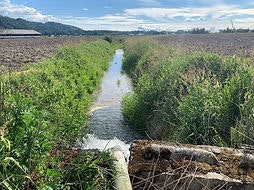Sub-irrigation Using Water Level Control Structures

The Whatcom CD has partnered with Washington State University Extension to conduct a demonstration project on the benefits of controlled drainage and sub-irrigation using Water Level Control Structures. Water level control structures (WLCS) such as Agri Drains are a tool to manage drainage on farm fields. The WLCS are left in open mode in the winter to allow draintiles and farm ditches flow freely and improve drainage for spring farming. Then in the spring once crops are planted, the WLCS are closed and used to slow drainage during low rainfall summer months. This project will evaluate WLCS performance on a local level by comparing fields with and without WLCS. Data being collected includes silage corn/perennial silage grass yields, soil moisture, irrigation water inputs, depth to groundwater, soil inorganic nitrogen, nitrate leaching, and surface and groundwater quality. The results of this evaluation will be conveyed to growers and other stakeholders in the agricultural community through outreach events organized by Whatcom Conservation District and through Washington State University Extension publications. The project is funded through a Conservation Innovation Grant (CIG) through NRCS.
Project duration: 2020-2023
